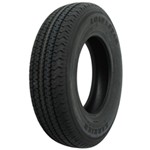
Difference Between Bias Ply And Radial Ply Trailer Tires And What Does Load Range Mean
Updated 01/27/2011 | Published 01/26/2011
Products Featured in This Question
Question:
What is the different between Bias ply vs Radial tires? and What is the load B,C,D mean? how do you know the weight in pounds capacity by using this load B,C,D capacity?
asked by: Jose
Expert Reply:
The main difference between bias ply and radial ply tire is how the tire is constructed. The cords underneath the tire are run in different directions. On a bias tire, the cords run at a 32 degree angle from the direction of travel and on a radial tire, the cords will run at 90 degrees from direction of travel, or across the tire from wheel lip to wheel lip.
Because of the construction of a radial tire, the tire has more flex and will allow for more ground contact. That will improve traction and better treadwear. It also gives the radial tire better stability.
A bias tire will have a stiffer sidewall and shoulder, which will increase heat buildup in the tire. The radial tire will run cooler which will help the tire last longer, especially when the tire is under a load. At one time the cost was a big difference, but now with the radial tires being close in price they are a much better value.
The B, C, and D is the load range of a tire. This is the maximum weight that the tire can carry at a specified maximum load inflation. The B is a 4-ply rated tire, the C is a 6-ply rated tire, and the D is a 8-ply rated tire.
The load range is stamped on each tire and right after the load range letter is the maximum weight at maximum psi for that tire. The load range weight capacity will also vary depending on the size of the tire. Trailer tires will always need to be inflated to the maximum psi that is specified on the tire.
The Trailer Tire and Wheel - 215/60-8 - 5 on 4-1/2 - Load Range C, part # AM3H310, has a maximum weight capacity of 935 lbs. at 50 psi.
The Kenda 215/60-8 Bias Trailer Tire with 8 Inch White Wheel - 5 on 4-1/2 - Load Range D, part # AM3H323, with a maximum weight capacity of 1,165 lbs. at 70 psi.
I am including a link to a FAQ page on tire information.

Product Page this Question was Asked From
Kenda 215/60-8 Bias Trailer Tire with 8" White Wheel - 5 on 4-1/2 - Load Range C
- Trailer Tires and Wheels
- Tire with Wheel
- Bias Ply Tire
- Load Range C
- 215/60-8
- 8 Inch
- M - 81 mph
- 5 on 4-1/2 Inch
- Steel Wheels - Powder Coat
- Kenda
more information >
Featured Help Information
Miscellaneous Media

Continue Researching
- Shop: Kenda 215/60-8 Bias Trailer Tire with 8" White Wheel - 5 on 4-1/2 - Load Range D
- Q&A: Recommended Tires And Wheels To Replace 18.5/8.5-8 Tires On Triton Trailer
- Shop: Kenda 215/60-8 Bias Trailer Tire with 8" Galvanized Wheel - 5 on 4-1/2 - Load Range C
- Shop: Kenda 215/60-8 Bias Trailer Tire with 8" White Wheel - 5 on 4-1/2 - Load Range C
- Q&A: Offset of 215/60-8 Tires and Wheel Combination
- Video: Review of Kenda Trailer Tires and Wheels - Tire with Wheel - AM3H323
- Search Results: 165/65~8 trailer tires and wheels
- Shop: Timbren Axle-Less Trailer Suspension w/ Idler Hubs - Standard Duty - No Drop - 5 on 4-1/2 - 2K
- Shop: Timbren Axle-Less Trailer Suspension w Idler Hubs - Standard Duty - 4" Drop - 5 on 4-1/2 - 3.5K
- Shop: Kenda 205/65-10 Bias Trailer Tire with 10" Galvanized Wheel - 5 on 4-1/2 - Load Range E
- Shop: Replacement Hub Assembly for Demco Kar Kaddy, Tow IT II, or Penske Tow Dolly - Qty 1
- Q&A: Recommended Wheel and Tire Combo w/ a 5 on 4-1/2 Lug Pattern that is 16" Tall
- Q&A: Does the Center Pilot Hole of a Trailer Wheel have to be Exact
- Q&A: What Is The Smallest Available Radial Trailer Tire?
- Q&A: What Does Ply Rating Mean on ST Trailer Tires?
- Q&A: 8 Inch Trailer Wheel That is Between 3-3/4" and 7" Wide







